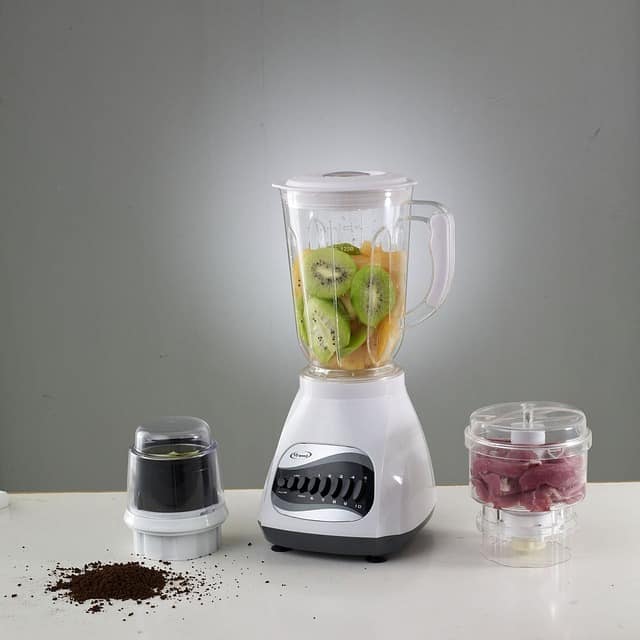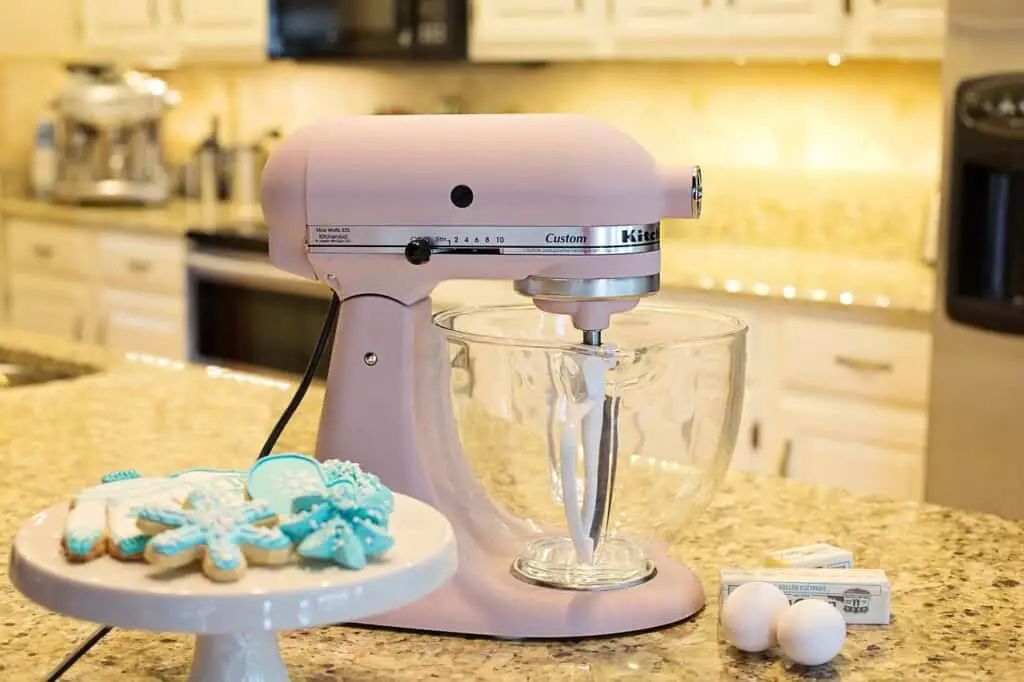At first glance, blenders and mixers seem to do the same job. However, there are some key differences between these two tools so we’re here to do the ultimate blender vs mixer breakdown.
Blenders and mixers have different primary functions. A blender breaks down solid foods into smaller pieces. This process often produces a powder or a liquid. Mixers, on the other hand, combine multiple ingredients into a single substance.
Blenders and mixers both play an important role in the kitchen. But while these tools each have unique uses, sometimes they are interchangeable.
This article will cover the differences between these important kitchen tools and will also provide some guidance on when and how to use them.
Table of Contents
Blender Vs Mixer
Let’s jump right in and talk about the differences between a blender and a mixer.
What Is A Blender?

A blender is made of two main pieces: the motor and the jar.
The motor is the base of the blender that has all the buttons and plugs into the wall.
The jar has a blade and a lid inside. This is where you put all the goodies you want blended.
The jar sits on top of the motor base which has notches in it that act like gears to turn the blade within the jar.
When you plug the motor in and hit a button, the motor spins the blade chopping up and mixing whatever you put inside.
What Is A Mixer?

A mixer is used primarily for baking to mix dough and batters. It will depend slightly on what kind you have, but most mixers are made up of two parts: the motor or base and the paddle.
If you’ve got a hand mixer, you will hold the motor in your hand and attach the mixing paddles to the mixer. Then, plug it in and move the paddles through what you want to mix to get a nice even batter or dough.
A stand mixer also has a motor and a paddle but it also has a bowl that attaches to it. The stand mixer will do all the work for you and you don’t need to use your hand to mix it around in the batter.
Now that you’ve got a clear image of a blender vs a mixer, let’s talk about when you should use each one.
When to Use a Blender or Mixer
Chart of Common Blender and Mixer Uses
| Recipe / Task | Blender | Mixer | Either One |
| Smoothies | X | ||
| Purees | X | ||
| Dips and Sauces | X | ||
| Cake Batter | X | ||
| Beating Eggs | X | ||
| Mashed Potatoes | X | ||
| Ice Cream | X | ||
| Shredding Chicken | X | ||
| Churning Butter | X |
The chart above shows some common uses for blenders and mixers. As you can see, there are certain scenarios in which you can use both. Let’s delve into the details of how to choose when to use a blender, a mixer, or either one.
To start, here’s a video that gives a nice overview:
When to Use a Blender
In the most basic sense, blenders turn solids into liquids. Blenders have powerful motors. This makes them a great tool to use when a recipe requires crushing or chopping up solid pieces of food or ice.
Common Blender Uses:
- Crushing
- Chopping
- Pureeing
- Liquifying
For instance, if you are making a smoothie or a pesto sauce, using a blender is your best option. A blender is strong enough to crush the ice and fruits you are putting into your smoothie and smoothly blend the nuts in a pesto.
These machines are also useful for creating dips, and milkshakes.
But keep in mind that there are times when you should never use a blender. Imagine you want to beat eggs or make mashed potatoes. A blender will be too harsh for both jobs.
Your eggs would become rubbery and your mashed potatoes would be like glue. In these cases, and many more, a mixer is your best bet.
When to Use a Mixer
When it comes to baking, a mixer is a vital tool. Mixers allow you to make cookie dough, whisk egg whites, and much more. These machines are a bit gentler than blenders. Rather than pulverizing food, mixers combine ingredients into a smooth consistent form.
You can also do a ton of other things with a mixer that you may not have thought of. Check out this article by Forkly to get some ideas.
Use a mixer any time a recipe asks you to do one of the following actions:
- Whipping
- Whisking
- Kneading
- Beating
When You Can Use Either One
Interestingly, there are some special occasions where you can use either one of these tools and get good results.
For example, both blenders and mixers can shred chicken. Even though mixers aren’t ideal for chopping food, cooked chicken meat is soft enough for a mixer to handle.
In addition, both these appliances can be useful in making homemade butter. You can expect either a blender or a mixer to be effective in churning cream or even making ice cream.
There are many more uses for blenders and mixers. But what is most important is understanding the blender vs mixer.
When in doubt, follow this simple rule of thumb:
- If you are breaking down solid pieces of food, use a blender.
- If you are combining ingredients without breaking down solids, use a mixer.
Different Kinds of Blenders and Mixers
Beyond their fundamental uses, there are different types of blenders and mixers. While they serve the same general functions, it is helpful to know about these different options when choosing between blenders and mixers.
Two Main Blender Varieties
Blenders come in two main varieties.
1. Immersion Blender
- Handheld
- Versatile
- Requires a Separate Bowl
2. Countertop Blender
- Larger
- Stands by itself
- Includes a built-in container
Immersion Blenders
The first type of blender is an immersion blender. An immersion blender is a hand-held blending tool. These blenders are sometimes called hand or stick blenders.
To use an immersion blender, put your ingredients into a bowl, turn the blender on, and move the blender throughout the bowl until your ingredients reach your desired consistency. This type of blender is lightweight and versatile.
Countertop Blender
The other main type of blender is called a countertop blender. One of the most obvious differences between an immersion blender and a countertop blender (other than their size/weight) is that a countertop blender can hold your ingredients rather than using a separate bowl.
The countertop blender will have an on switch or button and multiple blending settings.
The container provided with countertop blenders is usually transparent, which means you can watch as your blender liquifies your ingredients. This gives you a great ability to judge when your blending is complete.
Two Main Mixer Varieties
The breakdown of mixer types is very similar.
1. Hand Mixer
- Handheld
- Versatile
- Requires a separate bowl
2. Stand Mixer
- Larger
- Stands by itself
- Includes a built-in container
Hand Mixer
Like an immersion blender, a hand mixer is a lighter and more portable mixer option which makes them great for people like me who move a lot.
Hand mixers are easy to hold and to use, they are a good option for any baker.
Stand Mixer
In contrast to the hand mixer, a stand mixer is a more stationary tool. The stand mixer has a built-in bowl and can stand alone on your counter.
A stand mixer can save you some time in the kitchen because the stand mixer’s nature allows you to turn it on and let the machine run on its own.
While the stand mixer is working you can complete another separate baking task. Just make sure to keep an eye on the stand mixer and turn it off when mixing is complete.
Mixer Attachments
Mixers also have different attachments to consider. Depending on the mixer, you may find a:
- Whisk
- Kneading hook
- Flat beater or paddle
- Food processing equipment
These attachments are meant for different types of mixing jobs. The most common attachment is the flat beater. This is a versatile attachment that can handle many of your more common mixing needs.
If you are interested in buying a mixer, make sure you explore these attachment options and evaluate them as they relate to your favorite recipes (or new things you plan to try).
Price Differences Between Blenders and Mixers
Now that you know how blenders and mixers work, you are probably wondering how much it will cost to add these tools to your kitchen. The short answer is that prices can vary greatly.
The differences in cost are related to specific performance capabilities and special features. Luckily, Consumer Reports gives an outline of common blender prices and mixer prices. Below are price ranges for different types of blenders and mixers.
- Immersion Blender: $30-$240
- Conventional Countertop Blender: $40-$150
- “High-Performance” Countertop Blender: $300-$1,000
- Mixers (Hand and Stand): $20-$900
Before you buy, do some research to determine exactly what product you need. Don’t overpay for features that you won’t end up using. It is often most practical to select a simple appliance with good reliability.
Blender and Mixer Long-Term Use and Care
We all want reliable tools that we can count on for years to come. So, how can you make sure you are taking good care of your mixer or blender? There are a few easy guidelines you can follow to properly use either of these tools.
General Guidelines:
- Don’t force your appliance to do more work than it was designed to handle
- Clean your appliance right after use
Using and Caring for a Blender
- Don’t overfill your blender
- Start at a low setting and increase speed gradually
- Don’t run your blender for an excessive length of time for the task you’re asking of it
Make sure you wash your blender right after you use it. Pay close attention to the blades, being sure to remove any food that is stuck to them. Make sure you’re not making any of these blender mistakes.
For countertop blenders, cleaning is easy. Just put some warm soapy water into the blender and turn it on as you normally would during use. After a short time, and some thorough rinsing, your blender will be clean and ready to use again.
Using and Caring for a Mixer
As with a blender, you should not overwork your mixers. However, this is much easier to avoid since you won’t be using your mixer to break up hard pieces of food.
With mixers, cleaning is most important. For the sake of safety, make sure you unplug your mixer before you wipe it down. Since mixer attachments are removable, they are easy to clean separately.
Conclusion
As with any tool, you should know how to use and care for your blenders and mixers. Buy a quality machine and adhere to the good maintenance habits mentioned above.
By following these tips, you can ensure that your blender or mixer will serve you well for years to come.
